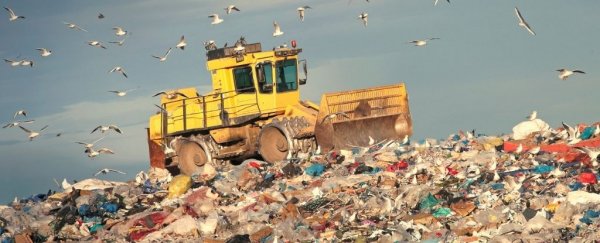In 2019, the United States sent an average of US$7.2 billion dollars worth of plastic to landfill, according to new estimates from the Department of Energy (DOE).
When considering the price of manufacturing, marketing and processing all that trashed material, the costs to the economy are significant. Nor does that consider the environmental price of plastic pollution.
While landfills are often considered the cheapest way to dispose of waste, in many ways that's a shortsighted approach. Setting up a system of recycling may cost more initially, but in the long run, a circular economy of plastics could save big bucks, anywhere between US$4.5 billion and US$9.9 billion.
At the moment, recycling plastic is more expensive than making new plastic, which means companies have little incentive to dig through landfills for old materials. In many ways that's because petroleum products are so cheap, but their inexpensiveness hides a deeper cost to our planet and, down the line, our economy.
According to the recent DOE analysis, about 44 million tons (Mt) of plastic waste were managed by private and public companies in the US in 2019.
That's way more than the number reported by the US Environmental Protection Agency, which sits around 32 million metric tons of plastic waste.
In 2019, researchers estimate only 5 percent of all that plastic was recycled. Meanwhile, about 86 percent was landfilled.
"Plastic waste is not just an environmental issue. It's a waste management issue. It's also a land use issue because landfills are closing in many areas," says energy analyst Anelia Milbrandt, who works at the DOE's National Renewable Energy Laboratory.
"What do we do with all that waste? It has to go somewhere."
Leaving it in a landfill is the easiest option, but not only does that waste money, it also wastes a massive amount of energy.
In 2019, the DOE analysis found plastic waste made up roughly 12 percent of the entire industrial sector's energy consumption in the US.
Manufacturing synthetic polymers requires the production of petrochemicals, which is a significant source of carbon emissions.
If just one ton of plastic is recycled, past estimates suggest it could save 13.8 barrels of oil and 810 cubic feet of landfill space.
In fact, the average 'embodied' energy of plastics is about 100 megajoules per kilogram. That's almost four times the energy contained in steel, which is one of the most energy intensive materials to produce.
"Using plastic waste instead of virgin plastic in products creates opportunities for energy savings and reducing the impact of embodied energy," researchers write.
The new estimates are based on 44 waste composition studies across 37 US states, with data covering more than 1,776 active landfills and 85 combustion facilities.
Nationwide, samples in 2019 suggest plastic waste constituted nearly 14 percent of all municipal solid waste.
In some states, like Kansas, Nebraska and North Carolina, the percentages of plastic waste in landfills reached 18 percent.
Of all the plastic products sampled, most fell into the categories of plastic film, plastic wrap and plastic bags. Plastic bottles were more likely to be recycled.
Populous states like California, Texas and Florida sent the most plastic waste to landfill. While New York City sent much of its plastic waste to surrounding states for sheer lack of space.
The authors of the report hope that their findings will help spur policy changes to promote a system of recycling throughout the nation.
Ever since China's recycling industry stopped taking America's plastic waste in 2018, landfills in the US have been piling up at a worrisome rate. Plastic initially destined for recycling plants has been sent to landfill instead.
Investing in new recycling technology could help divert some of that waste from landfills. As could better sorting techniques, so we can pick out recyclable materials in the cheapest and most efficient way possible.
"I believe local governments and industry developers will see a benefit of this report by providing them information to support decisions," says Milbrandt.
In the meantime, every bit of plastic we fail to reuse represents a loss of money, a loss of energy and a loss of opportunity.
The study was published in Resources, Conservation and Recycling.
